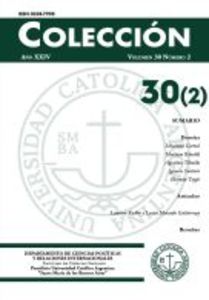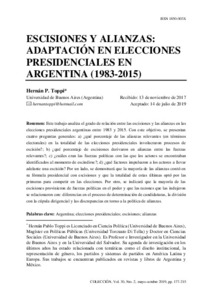Please use this identifier to cite or link to this item:
https://repositorio.uca.edu.ar/handle/123456789/9566| Título: | Escisiones y alianzas : adaptación en elecciones presidenciales en Argentina (1983-2015) | Autor: | Toppi, Hernán Pablo | Palabras clave: | Argentina; ELECCIONES; PARTIDOS POLITICOS | Fecha de publicación: | 2019 | Editorial: | Pontificia Universidad Católica Argentina. Facultad de Ciencias Sociales. Departamento de Ciencias Políticas y Relaciones Internacionales | Cita: | Toppi, H.P. Escisiones y alianzas : adaptación en elecciones presidenciales en Argentina (1983-2015) [en línea]. Colección. 2019, 30(2). Disponible en: https://repositorio.uca.edu.ar/handle/123456789/9566 | Resumen: | Resumen: Este trabajo analiza el grado de relación entre las escisiones y las alianzas en las elecciones presidenciales argentinas entre 1983 y 2015. Con este objetivo, se presentan cuatro preguntas generales: a) ¿qué porcentaje de las alianzas relevantes (en términos electorales) en la totalidad de las elecciones presidenciales involucraron procesos de escisión?; b) ¿qué porcentaje de escisiones derivaron en alianzas entre las fuerzas relevantes?; c) ¿cuáles eran las fuerzas políticas con las que los actores se encontraban identificados al momento de escindirse?; d) ¿qué factores impulsaron a los actores a llevar adelante una escisión? Por un lado, se demostrará que la mayoría de las alianzas contó en su fórmula presidencial con escisiones y que la totalidad de estas últimas optó por las primeras para competir en las elecciones. Por otro, se indicará que la mayoría de las escisiones provinieron de fuerzas políticas en el poder y que las razones que las indujeron se relacionaron con: diferencias en el proceso de determinación de candidaturas, la división con la cúpula dirigencial y las discrepancias en torno a la política de alianzas. Abstract: Abstract: This paper analyzes the degree of relationship between splits and alliances in the presidential elections in Argentina between 1983 and 2015. With this objective, four general questions are presented: a) what percentage of the relevant alliances (in electoral terms) in the entire presidential elections involved splitting processes?; b) what percentage of splits resulted in alliances between the relevant forces?; c) what were the political forces with which the actors were identified at the moment of splitting?; d) what factors urged the actors to carry out a split? On the one hand, it will be shown that the majority of the alliances counted in their presidential formula with splits and that the totality of the latter opted for the former to compete in the elections. On the other hand, it will be indicated that most of the divisions came from political forces in power and that the reasons which induced them were related to: differences in the process of determining candidacies, the division with the top leadership and the discrepancies in terms of the policy of alliances. |
URI: | https://repositorio.uca.edu.ar/handle/123456789/9566 | ISSN: | 0328-7998 (impreso) 1850-003X (en línea) |
Disciplina: | CIENCIA POLITICA | Derechos: | Acceso abierto | Fuente: | Colección. 2019, 30(2) |
| Appears in Collections: | COL - 2019 Año XXIV nro. 30-2 |
Files in This Item:
| File | Description | Size | Format | |
|---|---|---|---|---|
| coleccion30-2.jpg | 44,98 kB | JPEG |  View/Open | |
| escisiones-alianzas-elecciones.pdf | 338,67 kB | Adobe PDF |  View/Open |
Page view(s)
105
checked on Apr 30, 2024
Download(s)
400
checked on Apr 30, 2024
Google ScholarTM
Check
This item is licensed under a Creative Commons License

